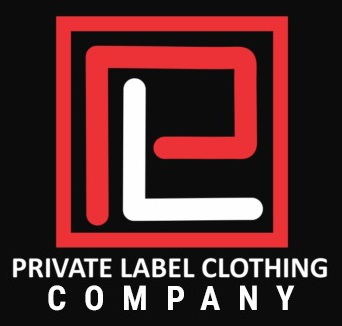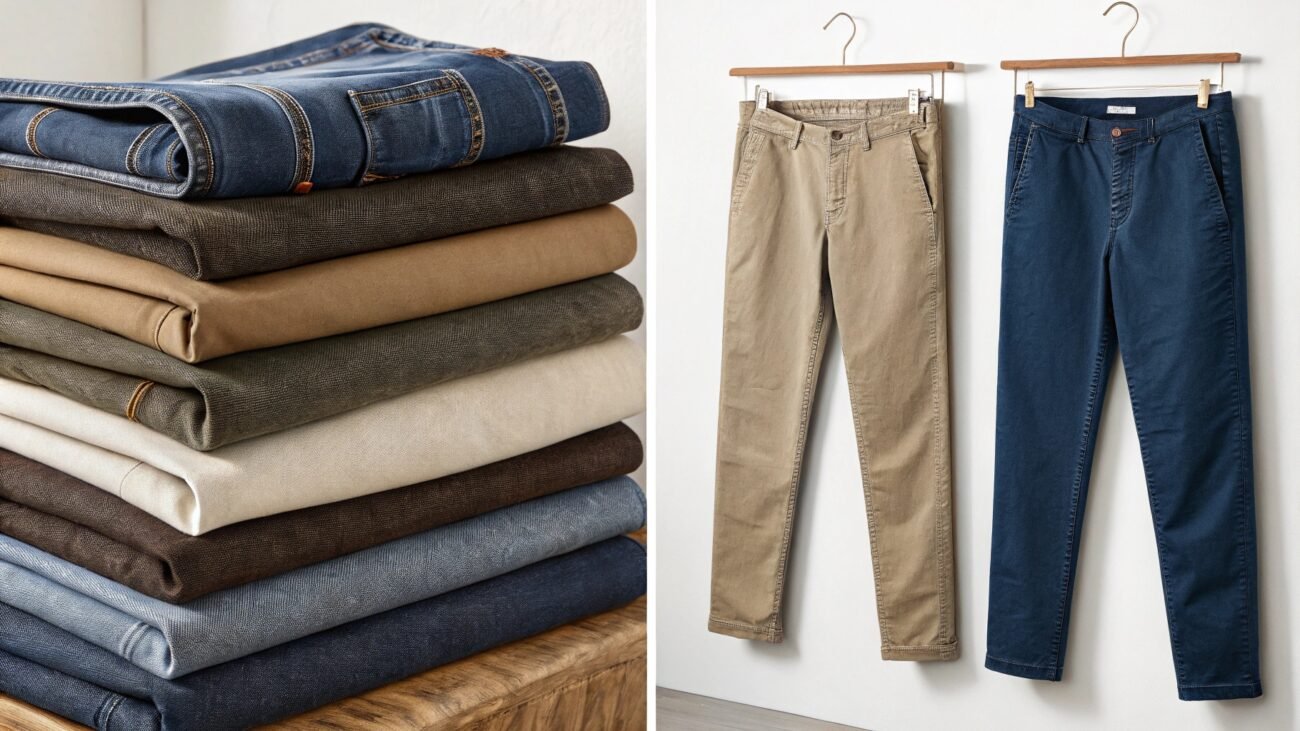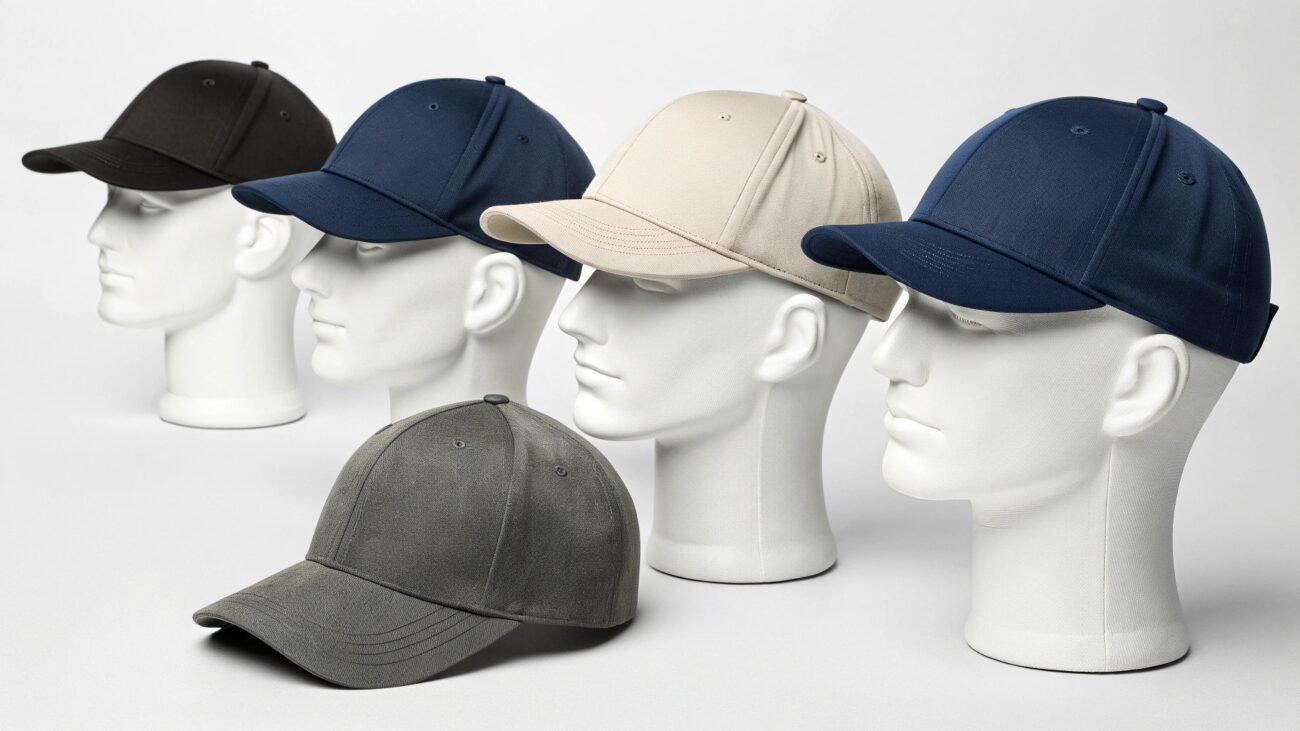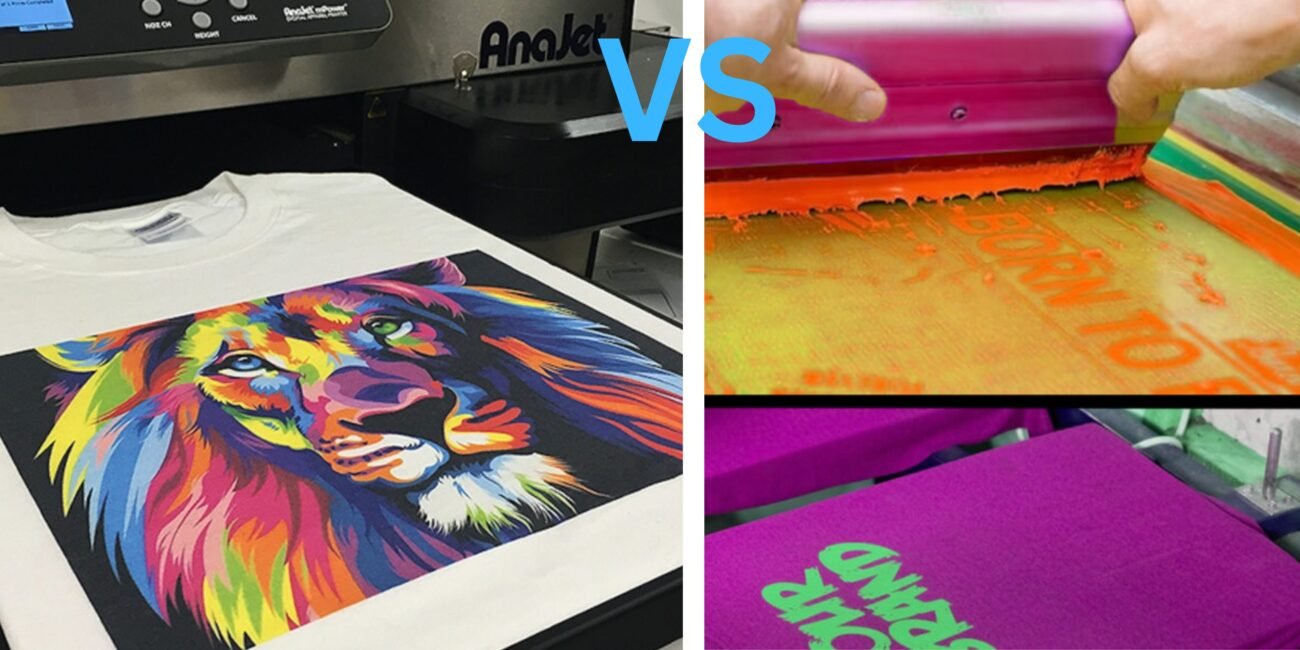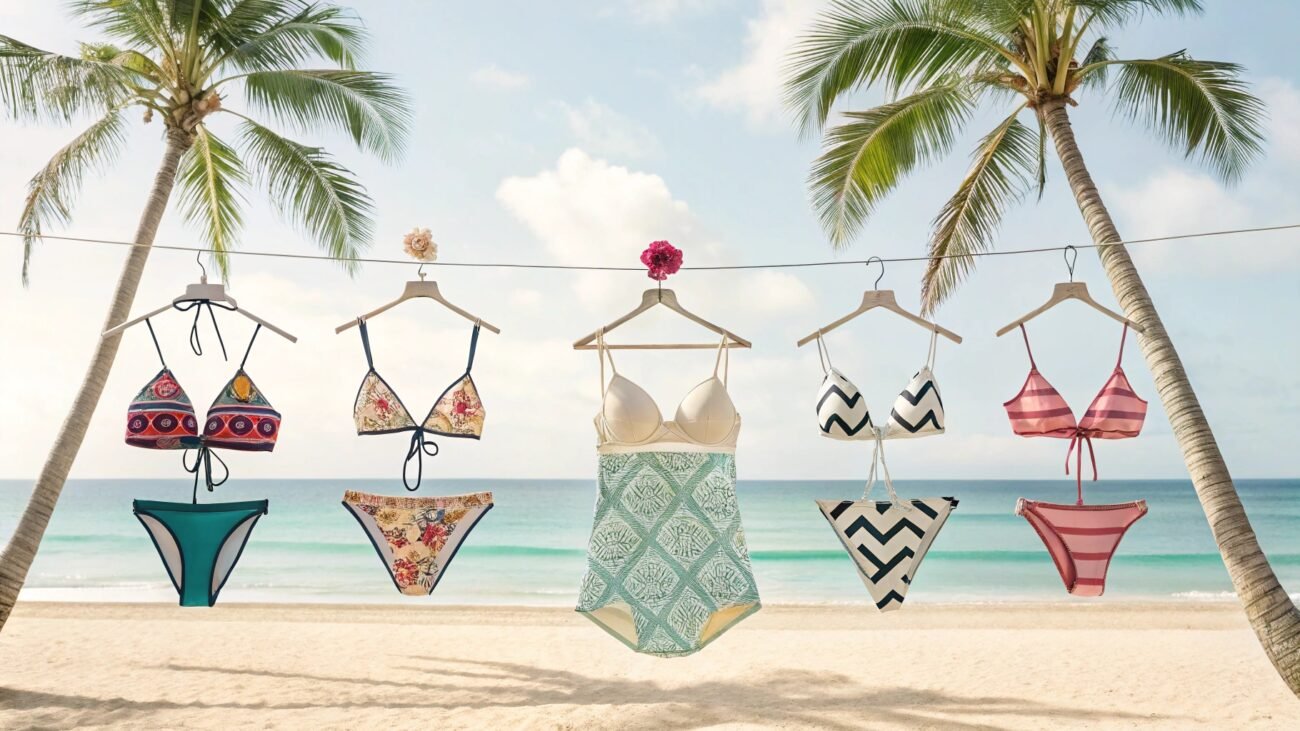You may have noticed that certain pants feel light to wear while others feel a bit rigid. If you think it’s because they are “brand new,” then you would absolutely be wrong.
Table of Contents
ToggleIn the market, there are multiple pants fabric types, and each of them is categorized by fiber content, Pre-treatments, and weave-style fabrics. Some are designed to provide exceptional softness, while others aim to be shape-conserving and color fasting.
Understanding these neat points of various pants-making stuff can allow you to select the right fabric type for your ideal pair of pants or trousers.
> Main Takeaways of Articles:
- Different fabric options for pants & trousers
- Tips on selecting the best pants & associated material
- How pants are different than trousers
We highly recommend you to read till last, as it will equip you with thorough knowledge regarding the most critical aspect of pants manufacturing being fabric types.
Introduction: How are Pants Material Different?
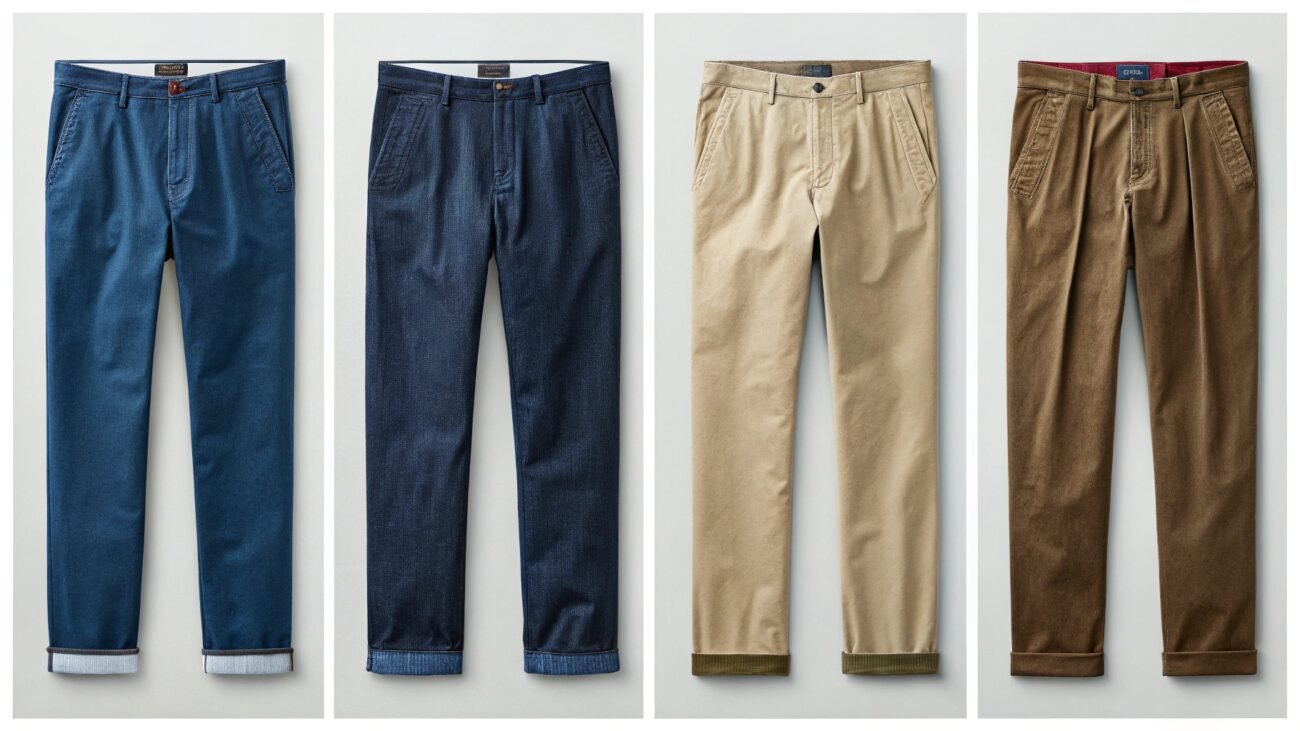
Pants or trousers are crafted using specialized material. Unlike T-shirts, Jackets, and other garment types, pants should only be manufactured using sturdier material.
If we go back just a few years ago, then we’d notice that pants were initially meant for working-class men; however, due to extreme popularity owing to their durability, fashion adaptability, and relatively affordable prices, pants are no longer just for the working class or let alone for men.
In the Market, there are multiple types of pants and trousers, each conferring a specialized use case.
| Fabrics for Pants | Fabrics for Other Garments |
|---|---|
| 200–500+ GSM | Wide range from 50–1000+ GSM |
| Structured & form-fitting drape | Soft, flowing, or crisp drape depending on garment type |
| Heavier & denser weave | Very light and open or heavy and insulating weave |
| High durability to resist day-to-day grind | Durability varies from low (T-shirts) to high (functional activewear) |
Qualities of Good Pants Fabrics
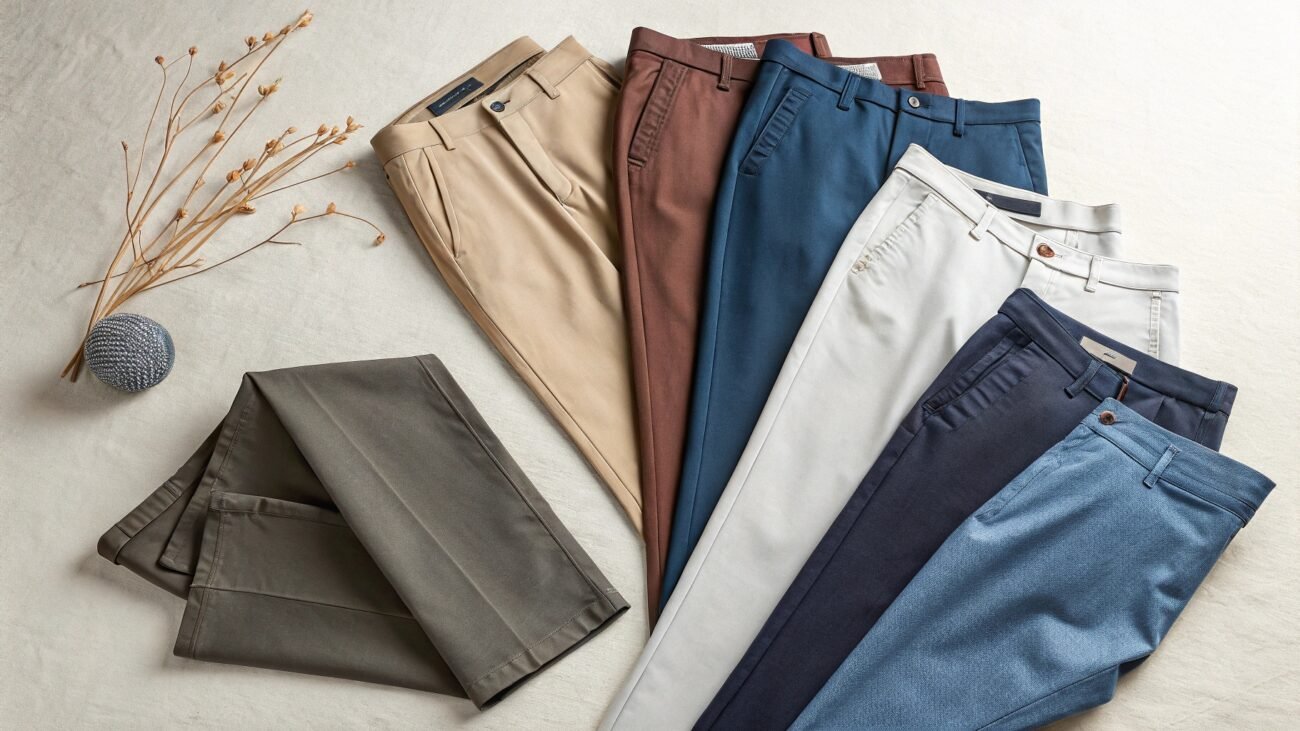
No matter what pant or trouser style you are going for, finding if the fabric involved has the following attributes or not can be very beneficial for both business persons and the regular population.
Strong & Resilient Fabric:
Pants are often roughened up due to daily wear, and a good pant fabric choice should automatically be strong and durable enough to withstand regular grinds such as tears, abrasions, and gradual inconsistencies.
Dense Weave:
Fabric used to make high-quality pants and tailored trousers should always be densely woven. There are lightweight pants in the market, but can we truly call them a pair of pants if they are not thick and long-lasting?
Stable form & Strectchability:
A fabric that doesn’t have sizeable stretch & shape recovery to it can never be used to make high-quality pants. Yes, there are “unwashed jeans” in the market that don’t stretch, but if you try to be more attentive, then it is because those jean pants are designed to stretch over a period of time in order to provide personalized fitting.
Wrinkle-resistance:
Another must-have characteristic is wrinkle-resistant; suppose you choose lightweight cotton for your premium leggings collection, but when worn, they will show creases and wrinkles, which will be very awkward for your customers. This is why opting for thicker fabric is always considered best to make pants.
Quick Note: Although these are some must-have properties of every common fabrics used in pants, depending on newer trends and fashion revolvements, don’t be surprised to see pant styles that don’t meet “all of the above” mentioned criteria.
Top Best Fabrics For Pants in 2025
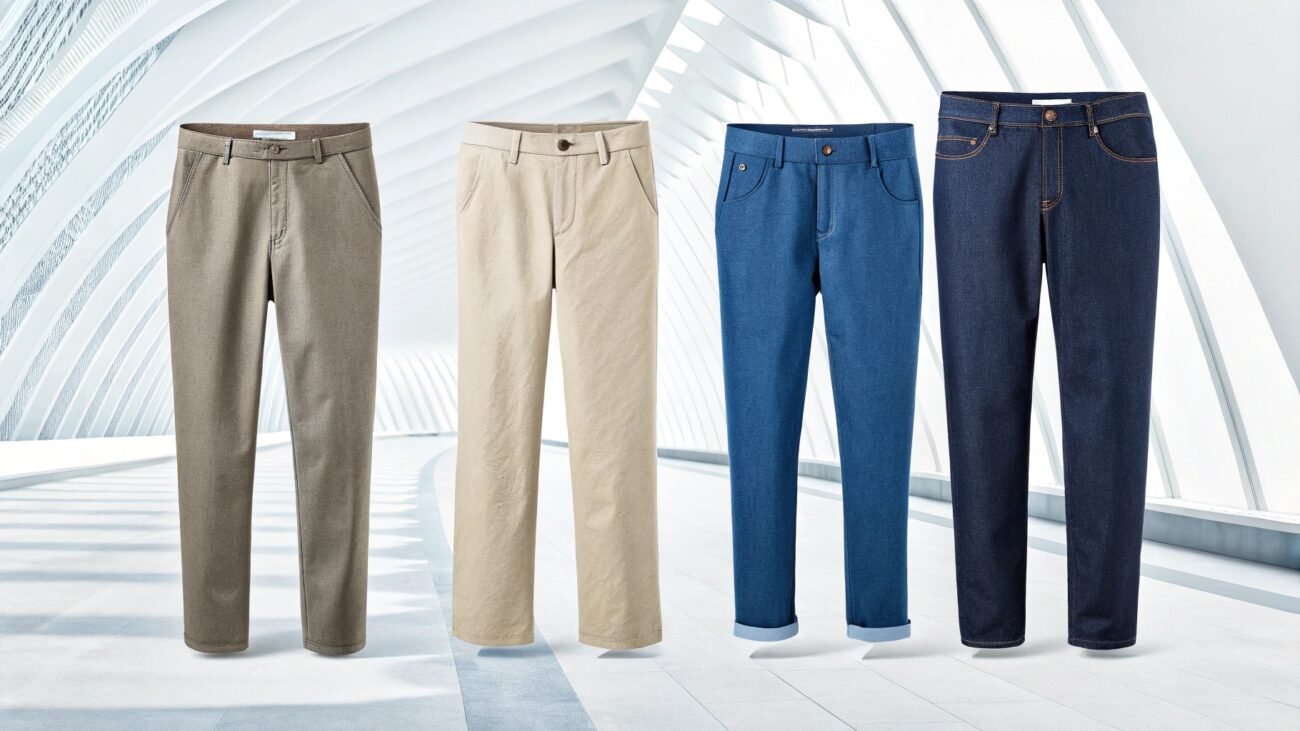
With the dawn of the textile industry, you can never be sure about the varieties of clothing material available in the market; however, due to this reason alone, There are many advanced and strategic fabric types readily accessible to make different clothes ranging from the ones focused on casual comfort to those specifically manufactured against extreme wear and tear.
Different pants and trouser fabric types have different extent of qualities to offer, and below listed are some of the most popular fabrics used in the lower garment industry.
Cotton Varieties:
Cotton is the most used textile in the clothing industry; it is a type of naturally obtained fabric with higher breathability, a gentle feel on the body, and softness.
But now you’d be thinking, if cotton is gentle and soft, then why is it considered a pants making material?
Well, when you go to textile mills or stores, you would be presented with cotton that is either weaved in such a way to provide a bit sturdier structure or cotton with higher gsm, and thanks to these compositional differences, there are also subcategories of cotton-based material used in everyday clothing, especially pants.
Denim:
A type of twill cotton fabric widely used to make jeans (Garments such as Shirts, Jackets, and Pants made with denim). It is characterized by its diagonal ribbed pattern, often dyed in indigo or blue color. Denim on its own is highly resilient and fades over time to provide that personalized aesthetic look.
Fun Fact: Although 100% cotton, modern denim often interludes the use of spandex and polyester for added stretch, comfort, and longevity.
If you want more information on Denim and its types, then you can visit one of our latest blogs.
Click Here: The Best Advice You Can Hear About Diverse Types of Denim
Pure Cotton:
Pure cotton that either comes combed or ring-spun is perfect for lightweight pants that are not just comfortable to wear but are also highly durable and stable. Cotton, even in its originality, is easily accessible and comes with additional features, including heat-trapping and quick drying.
Many people often opt for loose-fitting trousers made from cotton because of their high serviceability and manageable prices.
Other Use: Cotton is often blended with polyester and spandex to make high quality activewear clothes and reliable sets of trousers.
Canvas:
Another cotton variation, Canvas is celebrated for its excellent strength and longevity due to it being abrasive and water resistant, which makes it ideal for making work pants and casual pants.
What are canvas clothes good for?
Canvas-made clothes, especially pants, are great for high-impact and outdoor activities in colder weather thanks to their thick structure, which provides respectable insulation.
- Corduroy: You might think corduroy is not made with cotton fibers due to its raised parallel cords look and varied functionality of being velvety and insulative. But it is like this due to a specialized weaving technique where yarns are sliced into equal parts and then weaved vertically as fabric.
Corduroy’s unique appearance has made it a popular option for a variety of clothing such as feel premium trousers, shirts, and even home decoratives.
Some other attributes of corduroy are:
- Respectable durability.
- Wear & tear resistance.
- Porous surface for airflow.
- Moisture absorption.
Silk:
Silk is often questioned on its debatable sourcing, but there is one thing about silk that no one can deny. Whenever you want clothes that are a premium and luxury embodiment, then silk is the most preferred choice. It confers soft textures and incredible tear-free durability, which are highly sought-after properties for making top-quality lingerie and blouses.
However, due to being densely woven and durable, many fashion designers are collaborating with manufacturers like PLCM to make pants as well.
Linen:
Linen is naturally obtained from stems of flax plants and is a lightweight yet dense fabric used to make wide-leg pants. Linen-made trousers are handy in summer or whenever you are planning to visit resorts for vacation due to excellent sweat management and UV protection.
Related Read: The Ultimate Cheat Sheet On Lightweight Resort Fabrics
Rayon:
Rayon is a semi-synthetic fabric made using wood pulp from the eucalyptus tree and offers a lovely blend of softness and silk-like smoothness. Although it is not as durable as compared to other options on the list, it compensates by its budget-friendliness and breathable nature even when heavy in weight. Rayon is used to make stylish capri pants and budget-friendly evening pajamas.
Wool:
Wool is often considered for high-end trousers due to its exceptional warmth, insulation, and elasticity, which allows it to resist wrinkles and maintain shape even when worn and washed multiple times.
How is wool used to make pants?
The raw fleece obtained by the first sheer of sheep’s fur undergoes washing to remove debris and is then combed into longer fibers. Later, these fibers are spun into yarn and then woven into fabric for extra durability. Finally, woven fabric is patterned and then stitched into a functional pair of trousers or pants.
Drawbacks: Wool can be costly and can sometimes prove to be very itchy. It also needs a special dry cleaning routine that can pile up bills.
Spandex:
Also called Lycra or Elastane. Spandex is always blended with either cotton & polyester or nylon to impart special functions such as high flexibility, invariable fitting & muscle support. It is excellent for gym wear trousers where high support is required.
Quick-Note: Spandex-based clothes can easily lose their structural integrity if washed using hot water.
Polyester:
After cotton, polyester is the most used fabric in the clothing industry thanks to its advanced properties such as:
- Enhanced durability
- Sizable stretch
- Moisture wicking
- Wrinkle-resistancy
- Color retention
- Affordability
Manufacturers used polyester to make high-end activewear, traveling garments, and trousers for casual wear and work. However, there is only one setback of polyester, which is little to no breathability, but it can be easily worked around by blending it with cotton.
Why should a new business use polyester for their custom clothes?
Utilizing polyester is a wise choice due to its high cost-effectiveness, which can allow new businesses to explore marketing at competitive pricing. It also offers high resiliency and resists shrinking, meaning your customers will be happy with your clothes, which further means more brand loyalty.
If you want to start your own private label brand in 2025, then we highly recommend you to check out this blog from PLCM: Unleash Your Vision: How to Start a Private Label Clothing Brand.
How To Choose Best Material For Pants
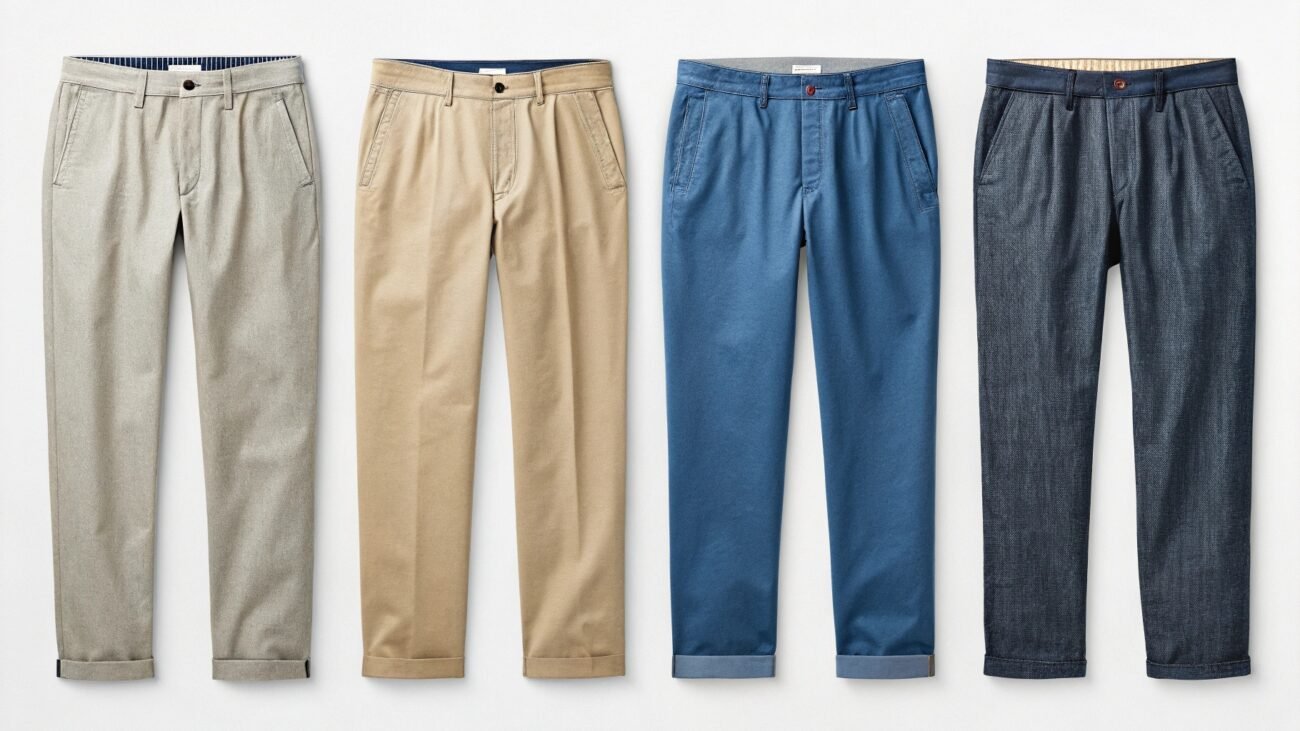
Selecting the right material can be extremely hard if you are not aware of different materials for pants and their associated qualities, but we believe now you are well equipped to understand the vast industry of pants fabrics, so we can venture further into the topic.
Think of it like this: Suppose you want to make custom trousers that need to have a little bit of porosity, but you opt for polyester. Then, the resulting pants would be durable and stretchy but would not be airy; this is why opting for the correct type of fabric is so important. In a nutshell, you can say, “Wrong fabric selection can set your brand for failure before your competitors.“
- To select the right trouser fabric, consider the following:
- Type of Pants or Trousers
- Which Functionalities does it need to offer
- Affordable alternatives
- Long time availability
For your convenience, we have devised a table explaining which consecutive pant material types are best for which pair of trousers or pants.
| Trouser Fabric Types | Best For? |
|---|---|
| Cotton | Cargo pants, Casual straight-leg trousers & Slim-fit pants |
| Denim | Exclusively for jeans pants such as skinny, straight and bootcut styles |
| Corduroy | Warmer straight-leg trousers, Relaxed-fit pants & Workwear pants |
| Canvas | Workwear pants, Utility trousers & Rugged cargo pants |
| Silk | Palazzo pants, Wide-leg dress trousers & Evening pants |
| Linen | Lightweight summer pants, Relaxed-fit trousers & Resort wear pants |
| Rayon | Palazzo pants & Comfortable joggers |
| Wool | Formal dress trousers, Suit pants & Smart-casual trousers |
| Spandex | Skinny jeans, Activewear leggings, Slim-fit chinos & Tailored trousers |
| Polyester | Activewear pants, Workwear pants, Travel pants & Dress pants |
Make Your Ideal Trousers with Us!
PLCM aims to provide not just high quality products, but also affordable pricings for our customers.
Conclusion
Lastly, we would like to say there are multiple pant material types, and each iteration confers to a specific set of qualities & setbacks, but when designing a pair of pants or trousers, it is crucial to select fabric that stands true to at least 3 points out of 4: being the resiliency, dense weave, stable-form, wrinkle-resistance.
If you are thinking about starting your own custom trousers business but have not been very successful in finding a startup-friendly manufacturer, then you can consider us for your business venture. PLCM is a high-capacity manufacturing factory that has been in business for decades and provides low MOQs of just 50 pcs of pants.
A typical process on our end:
- We receive your sample order with your idea of clothes.
- We craft free mockups to preview before production
- Then, our R&D experts will guide you along fabric selection.
- Afterward, we will apply your needed customizations to the pants
- Then, we will ensure consistent quality and send it on your way.
FAQs
1) Are pants & trousers the same?
Pants are the umbrella term for all leg-covering garments; however, trousers are specifically those pants that are more formal or tailored according to your measurements.
2) Why can’t spandex be used on its own?
Spandex is a material that is too stretchy and lacks structure on its own. Making a functional garment out of this is almost impossible due to it being uncomfortable and unsupportive. This is why it is always blended to impart its own functionalities to other fabrics.
3) Which fabric is best for printed pants?
Polyester is widely used for printed clothes, let alone just pants. It is made out of plastic polymers that hold designs and colors well.
